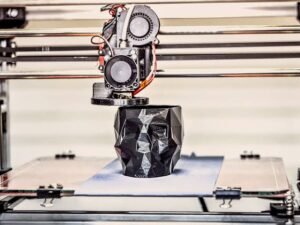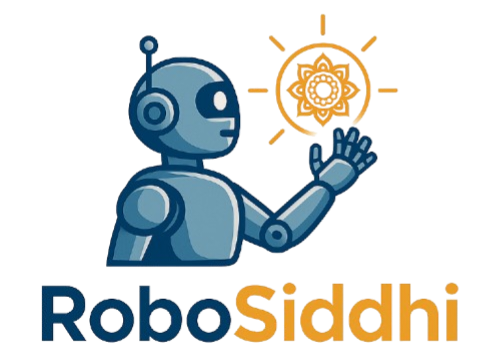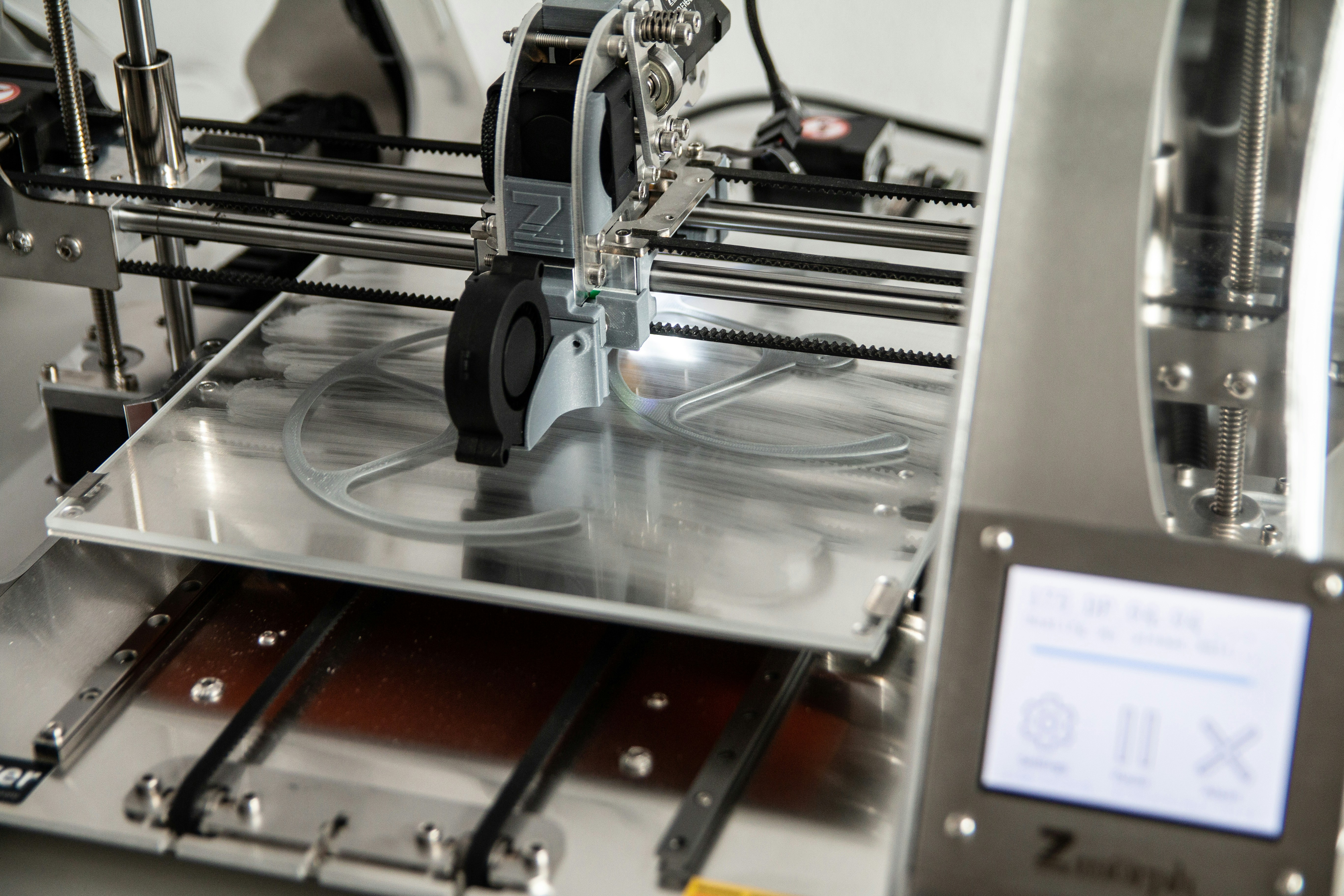Introduction to 3D Printin
3D printing, also known as additive manufacturing, is a transformative technology that enables the creation of three-dimensional objects from digital models. It employs a layer-by-layer fabrication technique, allowing for complex and customized designs. The evolution of 3D printing can be traced back to the 1980s when Charles Hull invented stereolithography, a process that utilizes ultraviolet light to solidify liquid resin. This breakthrough laid the foundation for subsequent advancements in the field, including technologies such as Selective Laser Sintering (SLS) and Fused Deposition Modeling (FDM).
Since its inception, 3D printing has experienced rapid growth, moving from a niche industrial application to a mainstream technology with diverse applications. Today, there are several types of 3D printers available, each catering to different needs. FDM printers are widely used for prototyping and small-scale production, while SLS printers excel in creating durable parts from powdered materials. Other technologies, such as PolyJet and Digital Light Processing (DLP), offer unique advantages in producing intricate designs and high-resolution outputs.
The significance of 3D printing has permeated various industries, including healthcare, automotive, aerospace, and consumer goods. In medicine, for example, 3D printing is utilized to create patient-specific implants and prosthetics, revolutionizing personalized treatment. In education, it serves as a valuable tool that encourages creativity and innovation among students, particularly in STEM (Science, Technology, Engineering, and Mathematics) fields. By allowing students to translate abstract concepts into tangible objects, 3D printing enhances hands-on learning, thereby enriching the educational experience and fostering problem-solving skills.
How 3D Printers Work
3D printing technology has gained immense traction in recent years, significantly influencing various domains, especially in the field of STEM education. The process of 3D printing, commonly known as additive manufacturing, begins with a digital model created using computer-aided design (CAD) software. This software allows users to craft intricate designs tailored to specific requirements. Upon completion of the 3D model, the next crucial step is slicing, which involves converting the 3D design into a series of two-dimensional layers. This layer-by-layer approach enhances the precision of the printed object.
Several techniques are employed in 3D printing, with the most prevalent being Fused Deposition Modeling (FDM), Stereolithography (SLA), and Selective Laser Sintering (SLS). FDM is characterized by the extrusion of thermoplastic filaments through a heated nozzle, building the model from the bottom up. This process is popular for its affordability and ease of use, making it ideal for educational environments. In contrast, SLA utilizes a UV light source to cure resin into solid layers, producing highly detailed prints suitable for prototypes and intricate designs. Meanwhile, SLS leverages a laser to fuse powdered material, often nylon or metal, creating durable end products but at higher costs.
The materials used in 3D printing are as diverse as the technologies themselves. Thermoplastics such as PLA, ABS, and PETG are prevalent in FDM applications due to their accessibility and ease of manipulation. SLA typically employs photosensitive resins that offer high resolution and a smooth finish, while SLS often uses engineering-grade powders that provide enhanced strength and durability. Each material has specific applications, catering to various needs from educational projects to industrial manufacturing.
The Importance of STEM Education
In today’s rapidly evolving digital landscape, the significance of STEM education—encompassing Science, Technology, Engineering, and Mathematics—has never been more pronounced. As society increasingly leans on technological advancements, fostering a robust understanding of these core disciplines becomes essential for students aiming to thrive in future professional environments. STEM education equips learners with integral skills and knowledge that are paramount in preparing them for a competitive and technology-driven workforce.
One of the primary benefits of a STEM-focused education is its emphasis on problem-solving. Students learn to approach challenges logically, breaking down complex problems into manageable parts. This analytical mindset is crucial, not only in scientific or technical settings but across various professions, enabling individuals to devise effective solutions and make informed decisions. Furthermore, STEM encourages creativity; students are often required to think outside the box and innovate. This nurtures a culture of invention and exploration, allowing them to conceptualize original ideas and implement them through practical application.
Moreover, STEM education fosters collaboration and teamwork. Many STEM projects involve group settings where students must communicate, share ideas, and build upon each other’s contributions. Such experiences prepare individuals for modern workplaces where collaboration is critical. Additionally, the integration of technology in STEM education enhances digital literacy, ensuring that students are well-versed in utilizing modern tools and resources effectively. This competency is essential as workplaces increasingly rely on sophisticated technology to drive productivity. Ultimately, by investing in STEM education, we are not just teaching content; we are nurturing a generation equipped with the skills necessary to navigate and shape the future in a technology-centered world.
Integrating 3D Printing into STEM Curriculum
The integration of 3D printing technology into STEM education presents an innovative opportunity to enhance students’ learning experiences. As educators strive to make the curriculum more engaging and relevant, 3D printing offers a practical application for fundamental principles in science, technology, engineering, and mathematics. This technology not only aids in making complex concepts more accessible but also promotes creativity and critical thinking among students.
One effective approach to incorporating 3D printing into the STEM curriculum is through project-based learning activities. For instance, students can design and create models of structures, such as bridges or skyscrapers, utilizing principles of physics and engineering. By drafting the designs in CAD software and subsequently printing the prototypes, learners gain a hands-on understanding of structural integrity and design considerations. This method encourages collaboration and problem-solving as students work together to refine their designs based on testing results.
Another example is utilizing 3D printing in biology lessons. Students can create models of different biological structures, such as cells or anatomical systems, which aids in visualizing and comprehending complex concepts. When students are able to hold and examine physical representations of their studies, their engagement increases, enhancing retention and understanding of the material.
Additionally, integrating 3D printers into mathematics lessons can be transformative. Students can model geometric shapes and figures, providing a tactile approach to learning theoretical concepts. By measuring, scaling, and printing these shapes, learners not only practice mathematical skills but also discover real-world applications of geometry in design and engineering.
Through these examples, it is evident that 3D printing can be strategically woven into various aspects of the STEM curriculum. By fostering a practical and engaging learning environment, educators are equipping students with the essential skills required for success in an increasingly technological world.
Benefits of 3D Printing in Education
3D printing technology is increasingly being integrated into educational environments, providing numerous advantages that enhance the learning experience. One of the most significant benefits of 3D printing in education is its promotion of hands-on learning. Traditional teaching methods often rely on theoretical approaches, but with 3D printing, students can physically create and manipulate objects, deepening their understanding of complex concepts across various subjects, including science, mathematics, and engineering.
Moreover, 3D printing encourages collaboration among students. Projects that involve 3D modeling and printing require teamwork, fostering communication and problem-solving skills. This collaborative environment not only enhances the social aspect of learning but also enables students to share diverse ideas and perspectives, contributing to richer educational experiences. The ability to work together improves student engagement, which is essential for motivation in the learning process.
The engaging nature of 3D printing captures students’ attention, making lessons more appealing and interactive. Instead of passively absorbing information, learners are actively involved in their education, which enhances retention and understanding. Furthermore, exposure to advanced technology through 3D printing cultivates creative thinking. Students are motivated to design their own models, which encourages innovation and the exploration of new ideas. This creative process is invaluable in developing critical thinking and design skills that are essential in today’s technology-driven world.
Finally, 3D printing provides practical experience in technology application. As students engage with this cutting-edge technology, they gain insights into the manufacturing and design processes, equipping them with relevant skills for future careers. By incorporating 3D printing into education, institutions not only enhance the learning experience but also prepare students for the demands of the modern workforce.
Challenges in Implementing 3D Printing in Schools
As schools increasingly recognize the potential of 3D printing technology to enhance STEM education, they must also address several challenges that may arise during the implementation process. One of the primary obstacles is budgeting constraints. Acquiring 3D printers and the necessary materials can represent a significant financial investment for many educational institutions, especially those operating under tight budgets. Schools must assess not only the initial cost of equipment but also the ongoing expenses related to filament, maintenance, and replacement parts.
Another considerable challenge is the training requirements for educators. Effective integration of 3D printing into the curriculum demands that teachers possess a strong understanding of both the technology and its application in teaching. Many educators may not have prior experience with 3D modeling or printing, thus necessitating professional development sessions. Schools must allocate time and resources to provide staff with adequate training to foster confidence in utilizing this technology within their teaching practices.
Furthermore, equipment maintenance adds another layer of complexity. 3D printers, like any other technology, require regular upkeep to function optimally. This includes cleaning, repairs, and troubleshooting various issues that may arise during use. Schools may face challenges in finding qualified personnel to manage these tasks, as expertise in equipment maintenance can vary widely. Establishing a support network with local businesses or engaging in partnerships with community organizations can serve as a viable solution to augment existing technical expertise.
Lastly, educators need to consider safety protocols while using 3D printers in the classroom. This includes ensuring proper ventilation and training students on safe handling practices. By tackling these challenges head-on and implementing practical solutions, educators can successfully integrate 3D printing technology into their STEM programs, ultimately enriching the educational experience for students.
Future Trends in 3D Printing and Education
The future of 3D printing technology holds great promise for transforming the educational landscape, particularly within the realms of STEM (Science, Technology, Engineering, and Mathematics). As educational institutions increasingly adopt this innovative technology, several trends are anticipated to shape its integration into curricula. One significant trend is the expansion of 3D printing applications across various disciplines, not limited to engineering and design. For instance, fields like biology and chemistry may leverage 3D printing to create models of complex structures, allowing students to visualize and manipulate concepts that are otherwise abstract.
In addition to the diversification of applications, the accessibility of 3D printing technology is set to increase. As cost-efficient printers and user-friendly software become available, schools and educational institutions can incorporate these tools into classrooms more readily. This democratization of technology enables students from varied backgrounds to gain hands-on experience in design and prototyping, fostering creativity and innovation. Furthermore, as industry collaborations grow, educational institutions may find themselves integrating real-world challenges and case studies into their 3D printing projects, creating a more engaged and relevant learning experience.
Moreover, advancements in materials science are expected to revolutionize 3D printing capabilities, providing a broader range of printable materials that can mimic the characteristics of traditional manufacturing. Innovations such as bio-printing and sustainable materials will allow students to explore environmentally friendly manufacturing processes, enhancing their understanding of sustainable practices in engineering.
Overall, the continued evolution of 3D printing technology promises to enhance STEM education, making it interactive and applicable to real-world challenges. As educators embrace these tools, they will not only prepare students for careers in high-demand fields but also cultivate a generation of innovative thinkers equipped to tackle future challenges. The synergistic relationship between 3D printing and education is poised to grow, ultimately enriching the educational experience and fostering a more profound understanding of complex scientific concepts.
Conclusion: The Future of 3D Printing in STEM Education
As we reflect on the transformative journey of 3D printing technology within STEM education, it is evident that this innovative tool plays a crucial role in shaping the learning experiences of students today. By integrating 3D printing into the curriculum, educators are not only enhancing hands-on learning but also fostering creativity, critical thinking, and problem-solving skills in students. The ability to turn abstract concepts into tangible objects makes complex theories in science, technology, engineering, and mathematics significantly more accessible.
Furthermore, the advantages of 3D printing extend beyond traditional educational boundaries. Schools and institutions that leverage this technology are preparing students for a workforce increasingly reliant on advanced manufacturing and engineering practices. The skills acquired through 3D printing experiences, such as design thinking and digital fabrication, are highly coveted in various industries, creating a valuable link between education and career readiness. This connection emphasizes the significance of teaching students not only how to use 3D printers but also how to think innovatively and collaboratively.
Moreover, 3D printing encourages an inclusive learning environment. Students of diverse backgrounds and learning styles can engage with the material in a way that resonates with them individually, thereby increasing participation and interest in STEM subjects. As we consider the future of education, adopting 3D printing technology paves the way for personalized learning opportunities and collaborative projects that empower students to take ownership of their educational journeys.
In conclusion, the integration of 3D printing in STEM education is a vital step toward revolutionizing how subjects are taught and learned. By embracing this technology, educators can facilitate an engaging, innovative, and inclusive learning atmosphere that prepares students for the complexities of the future. The prospects of 3D printing in education are vast, and its potential to inspire future generations to explore and excel in STEM fields is immense.

